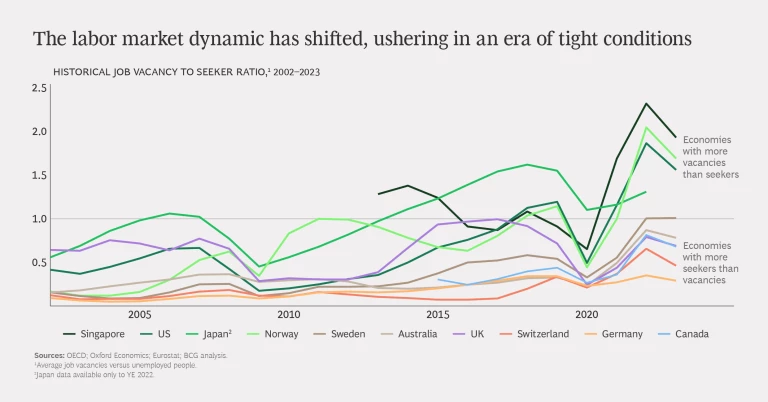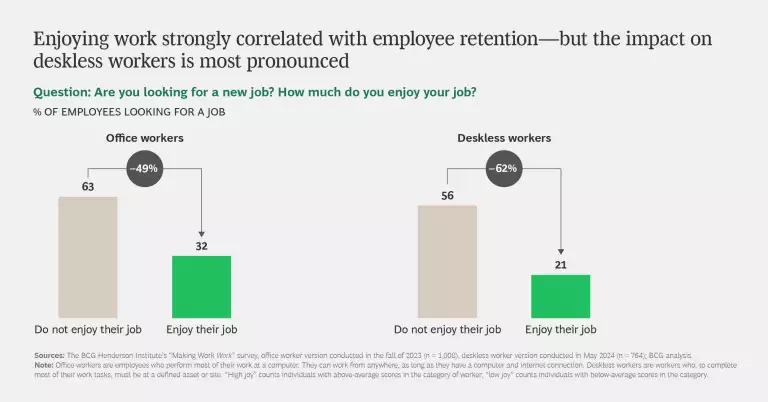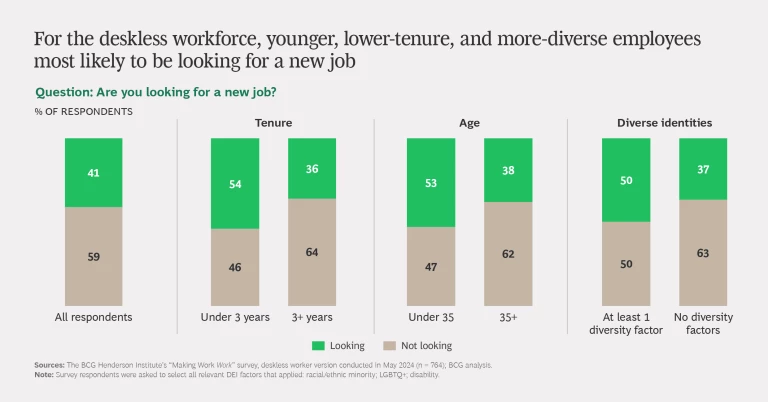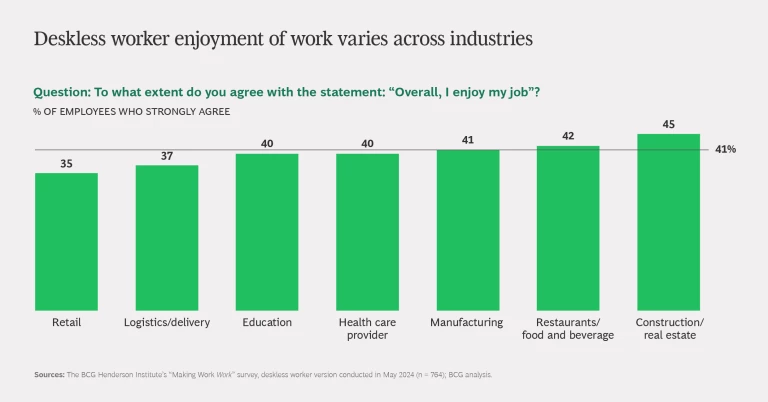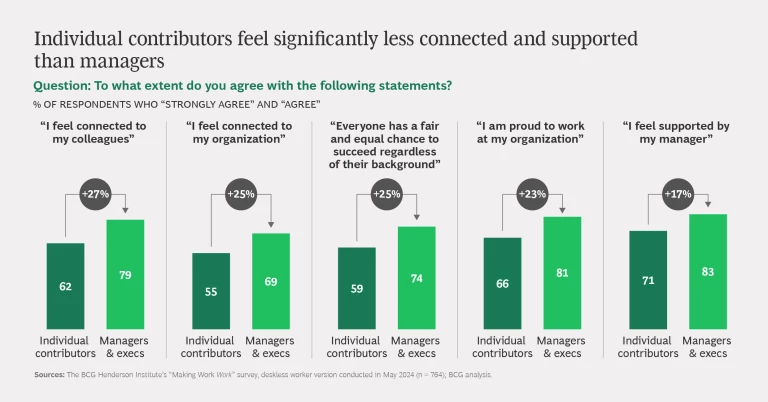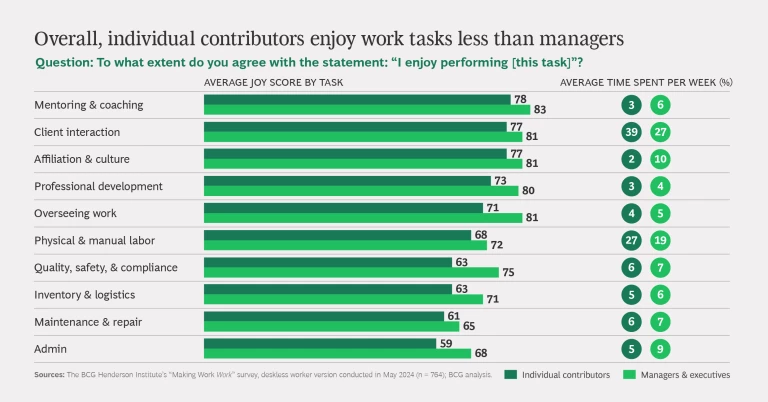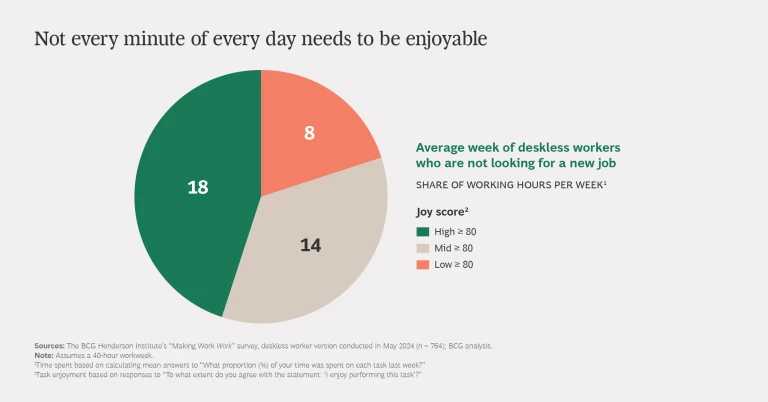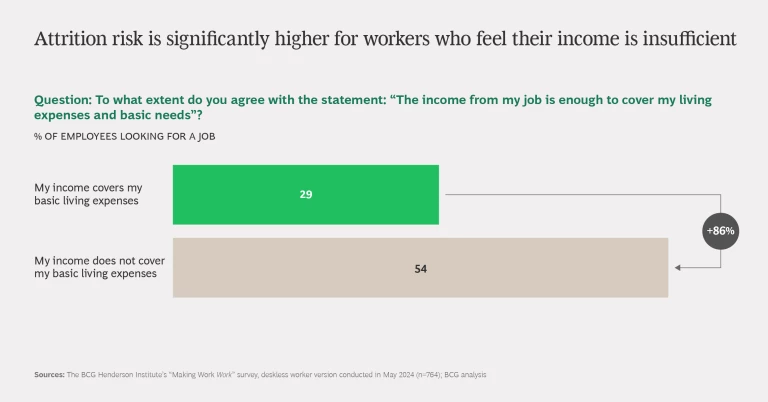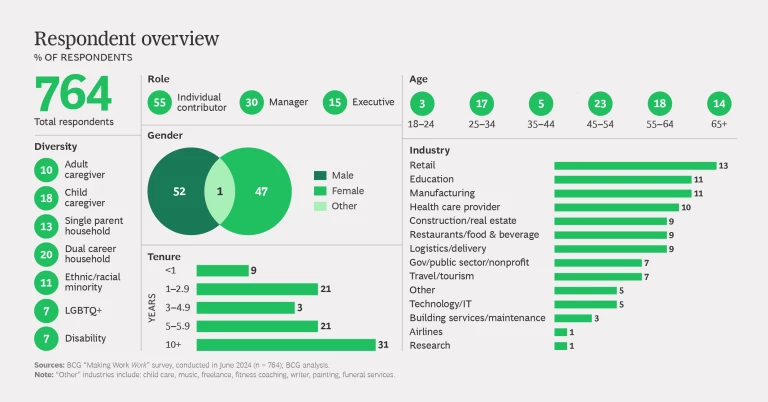Although the labor market has softened slightly in 2024, many economies are confronting some of the tightest conditions they have experienced in the last two decades. Just last year, Singapore, the US, Japan, Norway, and Sweden all had more job openings than job seekers. Layer on structural factors such as skills gaps and geographic constraints, and it’s clear why company leaders are still very worried about attracting and keeping great talent.
In an earlier version of our “Making Work Work” survey, we explored employment trends among office workers—defined as employees who can do most of their work from anywhere, provided they have a laptop and internet access. We found that people’s enjoyment at work strongly correlates with their decision to stay in their role. In the most recent iteration, we sought to understand the attitudes of deskless workers—those who need to be at a physical location or asset to conduct most of their tasks—toward their work.
Deskless employees make up roughly 80% of the global
Tracking Employee Attrition
Our survey results reveal that enjoying work matters even more for retention of deskless workers than it does of office workers: enjoyment can cut deskless workers’ attrition by 62%, compared with 49% for office workers. And, as with office workers, attrition risk is highest for younger, lower-tenure, and more-diverse employees. Among respondents who selected at least one diversity factor, those with disabilities and those who identified as LGBTQ+ reported the lowest overall joy (72% and 78%, respectively, versus 84% on average) and the highest attrition risk (52% and 50%, respectively, versus 41% on average).
Enjoying work matters even more for retention of deskless workers than it does of office workers: enjoyment can cut deskless workers’ attrition by 62%.
Across industries, we see some variability in how much deskless employees enjoy their work. Notably, this isn’t explained by demographics: retail, logistics, and education have some of the lowest levels of enjoyment despite having, on average, older and longer-tenured workers than other industries—workers who we have found typically enjoy their work the most. Probing deeper, we found that employees in retail, logistics, and education reported “feeling burnout” (26%), “feeling underpaid” (23%), and “feeling disrespected” (18%) as the key blockers to joy at work.
Bridging the Joy Gap
Among deskless workers, individual contributors (ICs) have a lower joy score (–10%) and higher attrition risk (+9%) than managers. When we investigated further, we found that ICs feel significantly less connected to their organization and colleagues and less supported by their managers, have lower levels of pride in their work, and perceive less fairness in their workplace.
This joy gap is observed not only when we ask deskless workers about their broader work environment, but also when we look at how they enjoy the components of their day-to-day work itself. We asked them to look at their week and tell us how much time they spent on a variety of tasks and how much they enjoyed each task. We found that at the task level, ICs consistently report lower joy scores across all tasks than managers, and that they spend more of their time on lower-joy tasks.
For example, for “affiliation and culture” work, there is a 4-percentage-point enjoyment gap between ICs and managers—although it is still one of the most enjoyable tasks for most cohorts. Not only do managers enjoy it more, but they also spend five times as much time per week on this task than ICs.
What to Do About Toil
Not every minute of the workday needs to be enjoyable: workers accept some amount of toil as part of their daily experience. We looked at the average joy/toil weekly breakdown and found that deskless workers who are committed to staying in their jobs (not looking for new work) spend nearly eight hours (or one day) per week on toil. It is important to highlight that these eight hours are offset by 18 hours of joyful work—a roughly 1:2 ratio. Office-based workers appear to have a lower “toil tolerance,” allowing only four hours of toil per week, alongside 14 hours of joy (a roughly 1:4 ratio) before they start looking for new opportunities.
Another key observation is just how much work is neither joyful nor toilful. These “neutral” tasks make up nearly 75% of ICs’ time. There is a clear opportunity to make some of these neutral tasks more enjoyable. For example, Sephora introduced color-coded shopping baskets that signal whether a customer wants assistance. This enabled associates to have more fulfilling engagements without feeling like they were unnecessarily annoying
Such operational actions are examples of interventions that make the work itself more enjoyable. But all too often, employee experience is relegated to HR, which has little influence over the day-to-day tasks that define that experience. Instead, business and line leaders need to own and prioritize redesigning work to make it more enjoyable for employees without losing efficiency and effectiveness.
The Big Picture
While our research shows how important it is to make work enjoyable, it’s important to bear in mind that joy at work is not a panacea, and it cannot offset the attrition risk associated with economic insecurity. The attrition risk for those who find their income doesn’t cover their living needs is 86% higher than for those who do (54%, compared with 29%). Within the former group, those who enjoy their work have a lower attrition risk—45% versus 54%—but it remains above the survey average of 41%.
Organizations must meet a set of basic employee needs, which includes providing a living wage and a safe workplace. But beyond providing these essentials, organizations need to ask their employees: What drives joy in your day? What is most important to you, day in and day out? By understanding the drivers of joy and sources of toil, leaders can make data-led choices and realize the true value of a motivated and joyful workforce.

